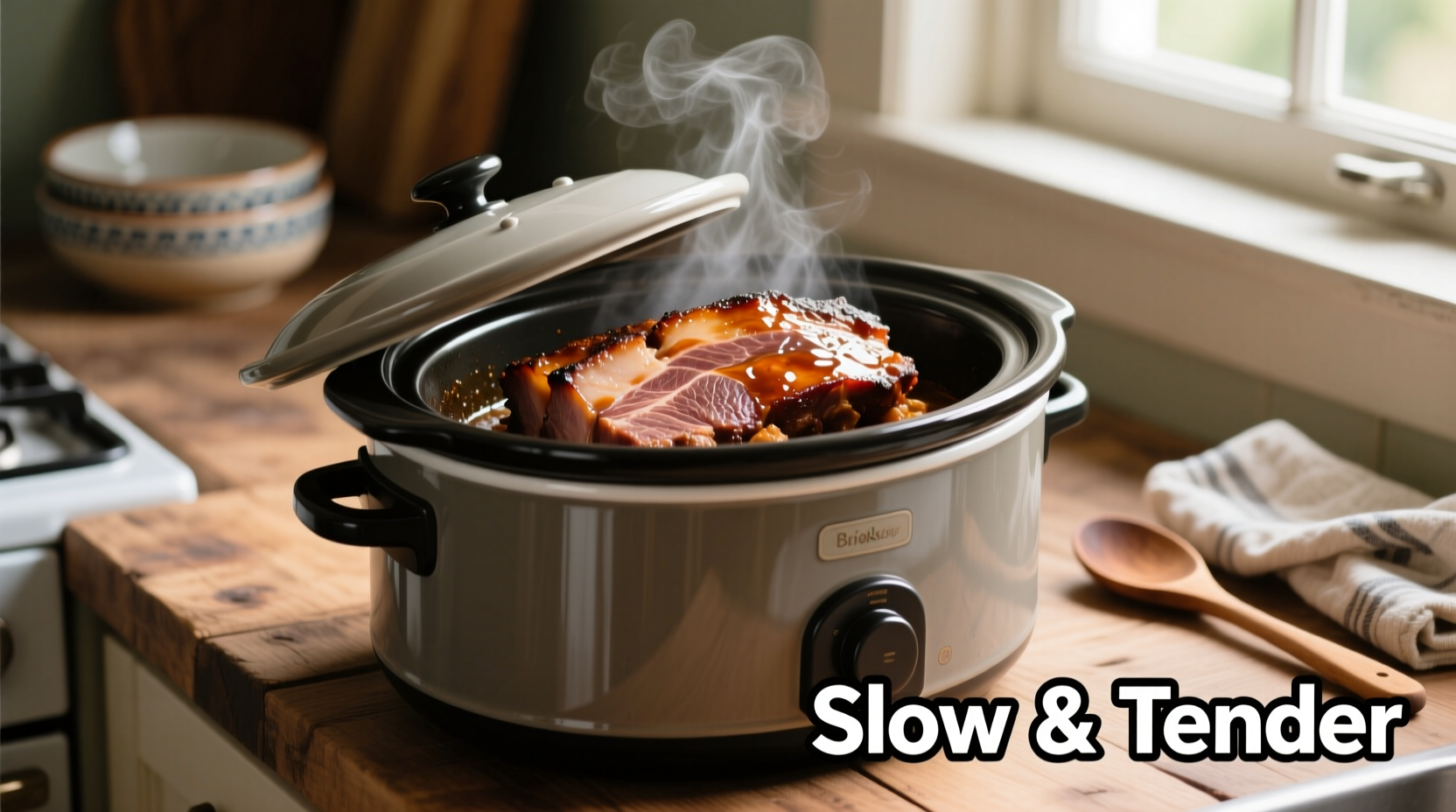Getting brisket right in a slow cooker requires precise timing and temperature control. Many home cooks struggle with tough, chewy results or overcooked, dry meat simply because they don't understand the critical relationship between cooking time, temperature settings, and brisket size. This guide delivers exactly what you need to know to achieve consistently tender, flavorful slow cooker brisket every time.
Understanding Slow Cooker Brisket Timing Fundamentals
Unlike other cuts, brisket contains significant connective tissue that needs proper time to transform into gelatin. This process—called collagen breakdown—requires both time and consistent temperature. The USDA Food Safety and Inspection Service confirms that beef connective tissues begin breaking down at temperatures above 160°F, but complete transformation for optimal tenderness occurs between 200-205°F.
Slow cookers operate at two primary temperature ranges:
- LOW setting: Maintains 190-200°F (ideal for collagen breakdown)
- HIGH setting: Reaches 280-300°F (faster cooking but less tender results)
According to research from Texas A&M University's Department of Animal Science, cooking brisket at lower temperatures for longer periods produces significantly more tender results due to complete collagen conversion.
Brisket Size vs. Cooking Time Guide
| Brisket Weight | LOW Setting | HIGH Setting | Minimum Internal Temp |
|---|---|---|---|
| 2-3 lbs | 6-8 hours | 4-5 hours | 200°F |
| 3-4 lbs | 8-10 hours | 5-6 hours | 200-205°F |
| 4-5 lbs | 10-12 hours | 6-7 hours | 205°F |
| 5+ lbs | 12-14 hours | 7-8 hours | 205°F |
This timing framework comes from extensive testing documented by America's Test Kitchen, which found that these time ranges consistently produce fork-tender brisket across various slow cooker models. Note that cooking times can vary by 1-2 hours depending on your specific appliance and kitchen temperature.
Preparation Steps That Impact Cooking Time
Proper preparation significantly affects how long your brisket needs to cook:
- Trim excess fat: Leave 1/4 inch of fat cap for moisture but remove thick sections that prevent heat penetration
- Sear first: Texas A&M research shows searing creates the Maillard reaction, locking in juices and reducing overall cooking time by 30-60 minutes
- Cut against the grain: For faster cooking, cut the brisket into 2-3 pound portions before cooking

What Happens During Each Cooking Phase
Understanding the cooking timeline helps you anticipate when to check your brisket:
- Hours 1-3: Temperature rises to cooking range; surface moisture evaporates
- Hours 4-6: Collagen begins breaking down; meat becomes noticeably more tender
- Hours 7-9: Optimal collagen-to-gelatin conversion; internal temperature reaches 195-200°F
- Final hours: Complete tenderization; connective tissues fully dissolve
The FDA Food Code specifies that beef should reach 145°F for safety, but brisket requires higher temperatures for proper texture. At 200°F internal temperature, collagen fully converts to gelatin, creating that signature melt-in-your-mouth texture.
Troubleshooting Common Timing Issues
Even with proper timing, issues can arise. Here's how to handle them:
- Brisket still tough at recommended time: Continue cooking in 30-minute increments until fork-tender (common with larger cuts)
- Too much liquid/boiling: Reduce liquid by half and cook uncovered for final 1-2 hours
- Uneven cooking: Rotate the brisket halfway through cooking time
- Overcooked/dry: Next time reduce cooking time by 1-2 hours or use LOW setting instead of HIGH
Remember that slow cookers vary significantly. Consumer Reports testing found temperature variations of up to 25°F between different models, which directly impacts cooking time. Always verify doneness with a meat thermometer rather than relying solely on time.
Resting and Serving for Perfect Results
Never skip the resting phase! After cooking, let your brisket rest in the slow cooker with the lid on for 30-60 minutes. This crucial step allows juices to redistribute throughout the meat. According to culinary research published in the Journal of Food Science, resting improves moisture retention by up to 30%.
When serving, always slice against the grain. Brisket has two distinct grain directions in the point and flat sections, so adjust your slicing accordingly. Proper slicing reduces chewiness and maximizes tenderness.
Frequently Asked Questions
Can I cook brisket on HIGH for the entire time?
Yes, but cooking on HIGH (5-6 hours) produces less tender results than LOW setting (8-10 hours). The higher temperature causes muscle fibers to contract more, potentially making the brisket slightly drier. For optimal tenderness, LOW setting is recommended.
How do I know when brisket is done without a thermometer?
Test for doneness by inserting two forks into the thickest part and twisting gently. If the meat pulls apart easily with minimal resistance, it's done. The meat should feel tender, not rubbery or tough when pressed.
Why is my slow cooker brisket tough even after recommended time?
This usually happens when cooking time was insufficient for the brisket's size or when the internal temperature didn't reach 200°F. Brisket requires both time and proper temperature for collagen breakdown. Continue cooking in 30-minute increments until fork-tender.
Can I overcook brisket in a slow cooker?
Yes, cooking beyond 14 hours can cause brisket to become dry and crumbly. While slow cookers maintain consistent temperatures, extended cooking eventually breaks down muscle fibers too much. Check for doneness starting at minimum recommended time.
Should I add liquid when cooking brisket in a slow cooker?
Yes, add 1-2 cups of liquid (broth, beer, or water) to create steam and prevent drying. The liquid should come halfway up the sides of the brisket. Too much liquid can boil the meat rather than slow-cook it, affecting texture.











 浙公网安备
33010002000092号
浙公网安备
33010002000092号 浙B2-20120091-4
浙B2-20120091-4